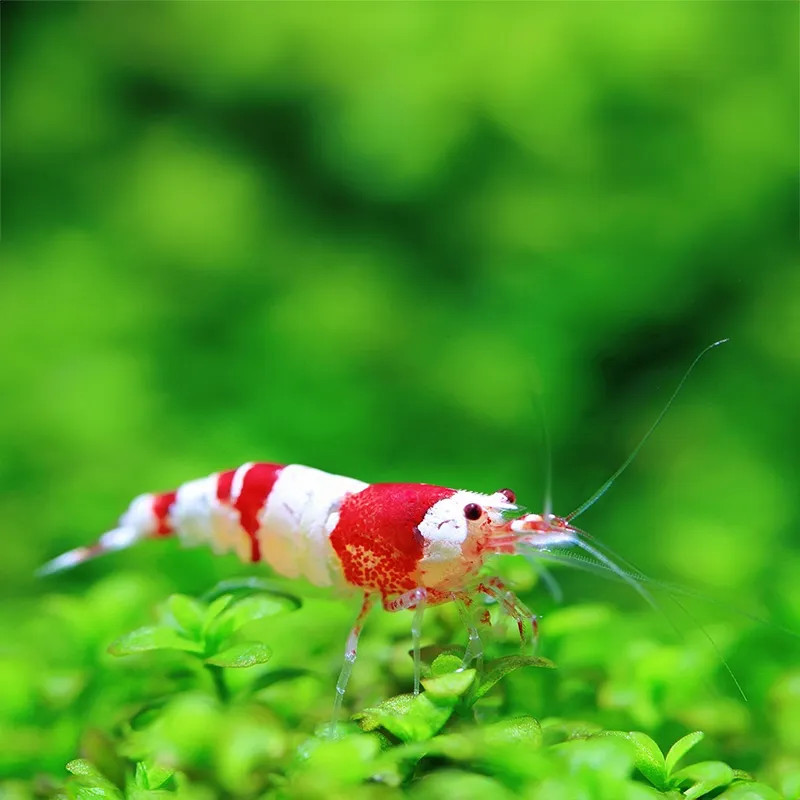Stocks Available
Blue Velvet Shrimp
SKU:112546
CARIDINA SP
1 INCH

Stock Available
Introduction Species: Caridina sp Common Names: Red and White Shrimp, Crystal Red Shrimp, Bee Shrimp Natural Habitat The Red and White Shrimp originates from freshwater streams and rivers in Southeast Asia. These habitats are clean, well-oxygenated, and densely vegetated, providing an ideal environment for this delicate species. Physical Characteristics Appearance: The Red and White Shrimp is famous for its stunning red and white banded coloration. The intensity and pattern of the colors can vary, with higher-grade shrimp displaying more vivid red and uniform white patterns. Their translucent legs and antennae add a delicate, elegant touch. Size: Grows up to 1-1.2 inches (2.5-3 cm) in length. Lifespan: Typically lives 1-2 years with optimal care. Habitat Requirements Tank Size: A minimum of 10 gallons is recommended for stability, as this species is sensitive to water parameter fluctuations. Water Conditions: Temperature: 68-76°F (20-24°C) pH: 6.0-6.8 (slightly acidic) Hardness: Soft water (4-6 dGH). TDS: 100-200 ppm. Aquascaping: Create a densely planted tank with mosses like Java Moss or Christmas Moss, which provide hiding spots and surfaces for biofilm growth. Driftwood and stones can enhance the tank's natural look and create additional surfaces for algae growth. Diet Primary Diet: Omnivorous; in the wild, they graze on biofilm, algae, and decaying plant matter. Supplemental Feeding: In captivity, offer high-quality shrimp pellets, blanched vegetables (e.g., spinach, zucchini), and occasional protein sources like spirulina powder or frozen daphnia. Feeding Frequency: Feed small amounts every other day, ensuring all food is consumed within 2-3 hours to prevent water contamination. Compatibility Temperament: Peaceful and social, Red and White Shrimp thrive in groups of 10 or more. Suitable Tank Mates: Best kept with other small, peaceful species such as Otocinclus, Neon Tetras, and Pygmy Corydoras. They can also coexist with other non-aggressive shrimp species. Incompatibilities: Avoid housing with larger or predatory fish, such as cichlids or fin-nipping species, which may harm or stress the shrimp. Care Level Difficulty: Moderate; this species requires stable water parameters and consistent care to thrive. Health Monitoring: Monitor for signs of molting issues, stress, or bacterial infections. Regular water changes and maintaining pristine water quality are critical. Breeding Breeding in Captivity: Breeding is relatively easy if water conditions are optimal. Spawning Behavior: Females carry eggs under their abdomen for about 28-32 days until they hatch into miniature shrimp. Provide plenty of hiding spots to protect the young. Economic Considerations Market Demand: Highly sought after by shrimp enthusiasts due to their unique coloration and aesthetic appeal. Pricing: Prices vary significantly depending on grade and pattern, with higher-grade individuals commanding premium prices. Sustainability and Conservation Wild Population: Not considered endangered, but habitat loss could pose a risk. Aquaculture Efforts: Widely bred in captivity to ensure a sustainable supply for the aquarium trade. Conclusion The Red and White Shrimp is a striking and elegant addition to freshwater aquariums. Their vibrant colors and peaceful demeanor make them a favorite among aquarists. While they require stable water conditions and attentive care, their beauty and fascinating behavior are well worth the effort. With proper care, these shrimp can thrive and even breed, adding life and color to any aquarium.
Data sheet
16 other products in the same category:
Customers who bought this product also bought: